Density functional theory investigation on Pd-catalyzed cross-coupling of azoles with aryl thioethers†
Abstract
In the present study, a density functional theory (DFT) study has been carried out on the Pd-catalyzed coupling of azoles with aryl thioethers. Our effort is mainly put into identifying the most feasible catalytic cycle, and especially the origin of chemoselectivity for the exclusive aromatic Csp2–S bond activation (in the presence of an alkyl Csp3–S bond). The coupling mainly consists of three steps: C–S activation, NaOtBu mediated C–H palladation, and reductive elimination. The Csp2–S activation is favored over Csp3–S activation, and thus di(hetero)aryls are the predicted products. This conclusion well reproduces Wang's recent experimental observations. The rate- and chemoselectivity determining steps of the C–H/Csp2–S activation mechanism are C–H palladation and C–S activation steps, respectively. Analyzing the origin of chemoselectivity, we found that the easiness of Pd catalyzed C–S activation is independent of the C–S bond strengths in thioether substrates. By contrast, d–π* backdonation in Csp2–S–Pd intermediates is the main driving force for the favorable Csp2–S activation (over the Csp3–S activation).


 Please wait while we load your content...
Please wait while we load your content...